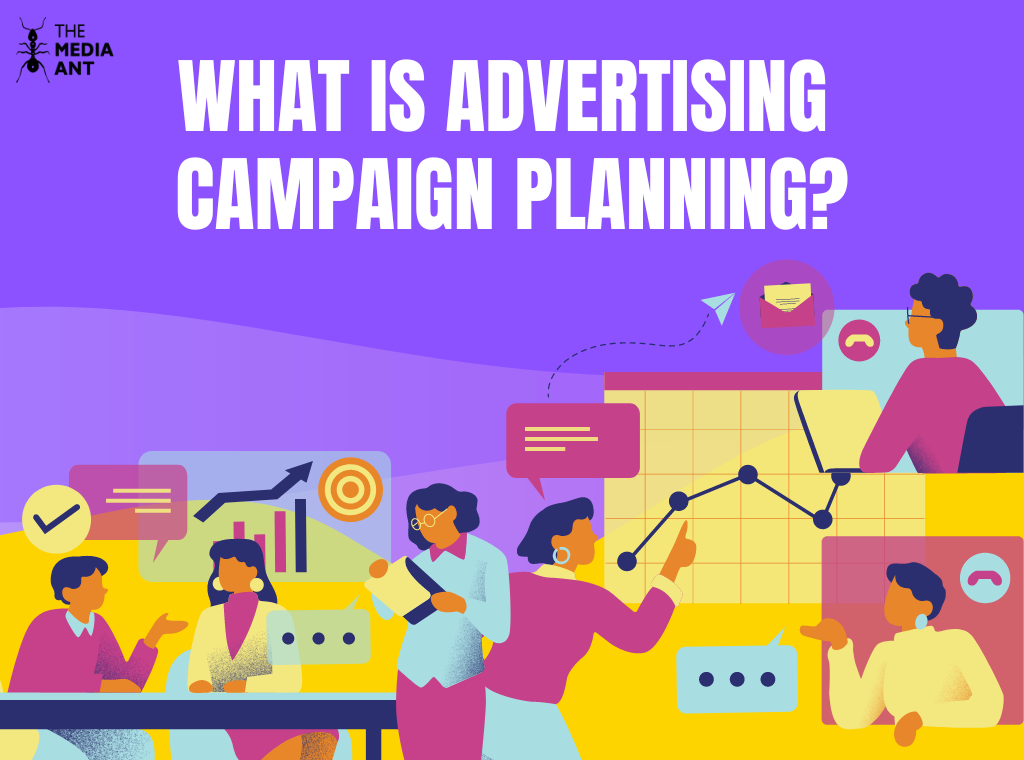In the exciting world of business, getting noticed is absolutely essential. That’s where Advertising Campaign Planning comes in as the genius behind the scenes, creating innovative strategies for brands to truly stand out. It’s a perfect combination of imagination and careful planning, where marketing ideas come to life. Picture a blank canvas, where every stroke has a purpose, and every color is chosen with intention. This is where campaigns come alive, telling captivating stories that effortlessly resonate with people.
Picture the excitement of introducing a fresh product, revealing an innovative service, or enhancing the visibility of your brand. This is where the magic of advertising campaign planning comes into play, surpassing mere promotions to create a holistic strategy. It goes beyond captivating visuals and memorable slogans; it’s about understanding the pulse of your audience, defining objectives, and devising a well-coordinated blueprint that not only captures attention but also accomplishes tangible marketing objectives.
Get prepared as we explore the complex world of advertising campaign planning, where every component adds to a narrative that surpasses the ordinary. It’s an expedition into the heart of marketing strategy, where imagination merges with methodology, resulting in an engaging encounter that leaves a lasting impression on consumers. Step into a realm where brands truly come to life, not only through their offerings, but also through the captivating tales crafted with meticulous planning and strategic excellence.
What is Advertising Campaign Planning?
In the vast world of business and marketing, advertising campaign planning serves as the guiding compass for brands in their promotional journey. It involves strategically planning a series of promotional activities to achieve specific marketing goals. Beyond catchy slogans and visuals, it focuses on understanding the target audience, setting clear objectives, and creating a well-coordinated plan for maximum impact. advertising campaign planning is like choreographing a marketing ballet, where every move contributes to the overall narrative. It aims to not only capture attention but also build a lasting connection with the audience. By crafting a story that resonates, it leaves a lasting impression on perceptions.
The process goes beyond creating noise; it’s about harmonizing creativity with strategy. It’s the roadmap that turns marketing goals into tangible results, ensuring every element works together seamlessly to enhance the brand’s presence. Essentially, advertising campaign planning is the blueprint that transforms business objectives into a captivating story that engages consumers in today’s ever-changing market.

Process of Planning Advertising Campaign
Exploring the complex process of planning an advertising campaign reveals a carefully designed journey from start to finish. The journey starts with a comprehensive understanding of the product, service, or message that needs to be communicated, followed by in-depth market research. This initial phase lays the groundwork, helping marketers identify target audiences, market trends, and potential competitors. Armed with valuable insights, the next step is to establish clear and attainable goals. These objectives act as guiding principles, shaping the campaign’s direction and providing a measurable standard for success. At the same time, a budget is determined, outlining the financial resources available for creative development, media placement, and other crucial elements.
The campaign’s personality is shaped through creative development. This includes creating captivating visuals, interesting copy, and strategic messaging that resonates with the target audience. Collaboration between creative thinkers and strategic planners ensures a perfect balance of innovation and purpose. After the creative assets are prepared, the media planning phase starts. This involves choosing the best channels to reach the target audience, whether it’s through traditional methods like TV and print or modern digital platforms. The selected media mix aims to maximize visibility and engagement while staying within the budget.
Implementation begins, launching the campaign on chosen channels. Monitoring and analytics are vital at this stage to evaluate performance in real-time. Adjustments are made to optimize impact and keep the campaign on track. Post-campaign analysis is the final step, providing a thorough assessment of success against set goals. Lessons learned guide future improvements, refining strategies for upcoming campaigns. Planning an advertising campaign is a dynamic journey where creativity, strategy, and adaptability come together to create a compelling narrative for the target audience.
Factors Influencing Advertising Campaign Plan
Navigating the world of advertising campaign planning involves carefully considering various factors that can impact the direction of a campaign. These important elements serve as a guide for marketers as they make choices and decisions.
Let’s explore the details of the Factors that Influence Advertising Campaign Plans, uncovering the intricate relationship between strategy and external forces.
1. Understanding the Target Audience
The first step in this process is understanding the audience. By studying consumer demographics, preferences, and behaviors, marketers can create a campaign that resonates with the intended recipients.
2. Budget Constraints
Another important aspect to consider is the budget. Financial considerations influence creative decisions, media selection, and the overall scope of the campaign. Balancing aspirations with fiscal realities is crucial for ensuring the feasibility and success of a campaign.
3. Analyzing the dynamics of the market
Understanding the competitive landscape is crucial in the dynamic market. By analyzing competitors’ strategies, a unique campaign can be developed to stand out and attract attention.
4. Selecting media channels
Selecting the appropriate media channels is a key decision. Whether it’s social media, traditional advertising, or a combination, knowing where the target audience is most engaged ensures the message reaches the right people.
5. Implementing innovative strategies
Keeping up with technological trends is essential in the fast-paced world of advancements. By staying updated, innovative strategies can be implemented to keep the campaign relevant in the evolving landscape.
6. Regulatory Environment
To avoid damaging the brand’s reputation or facing legal consequences, campaigns must adhere to regulations and ethical considerations. It is important to follow legal standards and industry norms.

7. Cultural Sensitivity
When planning a global campaign, it is crucial to understand different cultural landscapes. This helps prevent unintentional mistakes and ensures that the message aligns with the values and sensitivities of diverse audiences.
In advertising campaign planning, these factors work together to guide marketers in creating campaigns that grab attention and resonate genuinely with the target audience. Each factor plays a role, just like a note in a symphony, contributing to the success of an advertising campaign and leaving a lasting impression on consumers.
FAQs on Advertising Campaign Planning
What are the steps in advertising campaign planning?
The process of planning an advertising campaign typically involves several steps:
1. Defining objectives: Clearly establish specific goals for the campaign.
2. Analyzing the target audience: Conduct thorough research and analysis on the demographics, behaviors, and preferences of the intended audience.
3. Crafting a message: Develop a compelling and impactful message that resonates with the target audience.
4. Selecting media channels: Determine the most suitable and effective platforms to reach and engage the target audience.
5. Allocating a budget: Set aside funds for different aspects of the campaign, ensuring proper allocation and resource management.
6. Executing the campaign: Implement the plan according to the predetermined schedule and strategy.
7. Assessing results: Measure and evaluate the campaign’s effectiveness by comparing the achieved results against the initially set objectives.
What is the campaign planning process?
The process of planning a campaign usually includes establishing goals, conducting research on the target audience, creating a message, choosing suitable media platforms, determining a budget, executing the campaign, and assessing its impact. This cyclical process guarantees that the campaign is in line with strategic objectives and effectively connects with the desired audience.
How do you write an advertising campaign plan?
Begin by establishing precise goals and pinpointing the specific demographic for your advertising campaign. Carry out extensive research to grasp their requirements and inclinations. Develop a persuasive message and choose appropriate communication platforms to effectively engage the target audience. Establish a practical budget and schedule, and execute the plan accordingly. Lastly, assess the campaign’s effectiveness in relation to the predetermined objectives and make any essential modifications.
What are the 5 key steps in creating an advertising campaign?
The process of creating an advertising campaign involves five essential steps:
1. Establishing clear goals for the campaign by defining objectives.
2. Conducting research to gain insights into the demographics and preferences of the target audience.
3. Crafting a compelling message that resonates with the audience.
4. Selecting appropriate platforms to effectively reach the target audience by choosing media channels.
5. Executing the campaign and measuring its performance against the set objectives to implement and evaluate its success.





